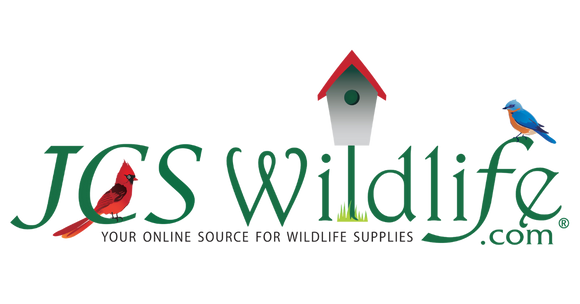This beautiful hand-made Bee House is made by JCs Wildlife from recycled Poly Lumber. It features all screwed construction using stainless steel screws and routed edges. This house will not crack, split or fade - it will look great for years to come. The colors are vibrant and UV protected. The interior boasts 8 rows of panels perfect for mason bee nesting and are removable for easy cleaning. The charred pine used to make the bored panels makes for a cozy home as well. The poly lumber is stain proof, and helps make the entire house easier to clean and maintain. Made in the USA!
Your bee house will attract mason, orchard, leaf-cutter, aphid or carpenter bees. Attach the nesting box on the side of a post or building by using the included mounting hardware. The house should face East or Southeast. Bees love the morning sun which helps them fly early to collect pollen. Never place a bee house near an area where pesticides or herbicides are used. The house should be positioned 3-5 feet off the ground. The bees will find the house without any help.
Spring
When the weather starts to warm up to 55°F, you will start to see adult mason bees in your area. This is the time that the males and females mate and the females will start looking for a location (your bee house) to lay her eggs. Typically the females will lay eggs until the end of Spring. It is very important to have your bee house up and ready before the adults emerge from their Winter nap.
Summer
After about a week, the eggs will hatch inside the house and the larvae will feed on the pollen and nectar that is available in each slot. In late June, the larva will spin a cocoon and begin to develop into an adult bee inside the cocoon. During this period, you will not see any bee activity on the outside of the bee house. Do not disturb the house at this time.
Fall
In October, you can finally remove the panels and see the cocoons inside the slots. Each nesting slot can contain up to 8 cocoons. At this time, you can carefully remove the cocoons and place them inside a container and store them in the refrigerator.
Winter
The cocoons are resting inside the refrigerator or outside in the bee house. The cocoons will hibernate for nearly 6 months. Make sure your house is clean and ready to go for Spring. Be sure to remove all of the nesting material from each slot in the house.
Next Spring
Once the temperature reaches 57°F for several days, remove the cocoons from the refrigerator and place them outside to emerge. Usually this will be in late February or early March. Be sure to protect the cocoons by leaving them inside of a container. Place a small hole on one side of the container for the adults to escape once they emerge from their cocoons. Now the cycle starts all over again! For more information on timing and species available in your area, contact your local extension or farm bureau office.
Mason Bee Fun Facts
Mason bees are 30-60 times more effective at pollinating than honey bees.
One female mason bee is like having 100 honey bees.
Adult mason bees only live for 3-6 weeks.
Mason bees use mud to construct the walls between the cocoons.
6 mason bees can pollinate one fruit tree compared to 10,000 honey bees.
A female mason bee will visit 75 flowers per trip.
Each larvae will need pollen and nectar collected from nearly 35 foraging trips.
They do not make holes, they only use natural holes or holes created by man.
A single bee will visit up to 2,400 flowers per day.
Mason bees are non-aggressive and very safe for children to observe.
During foraging, mason bees will pollinate over 90% of the flowers they visit.
Males are the first to emerge in the Spring.
Mason bees will range 100 yards.
One female can lay 36 eggs.
The female determines whether to lay a male egg or a female egg.
Unlike honey bees, mason bees are native to North America.
Mason bees use scent to locate their nest hole.
Finally, mason bees are awesome!



























